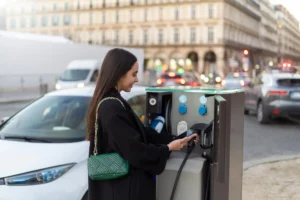
Home / EV Charging News / What are electric car batteries made of?
Electric vehicles (EVs) have gained significant traction in recent years as a sustainable transportation option. At the core of these vehicles’ functionality lies the electric car battery, a sophisticated energy storage system that powers the electric motor. In this article, we will delve into the composition of electric car batteries, examining the key components that make up these advanced power sources.
Electric car batteries play a pivotal role in the operation of EVs. Unlike internal combustion engines that rely on fossil fuels, electric cars harness the power of electricity stored in their batteries to generate torque and propel the vehicle. This transition to electric power brings numerous benefits, including reduced greenhouse gas emissions, improved air quality, and decreased dependence on fossil fuels.
Electric car batteries are complex systems composed of various components working in harmony to store and deliver electrical energy. By comprehending the composition of these batteries, we can gain insight into their performance, durability, and potential for further advancements.
Lithium-ion batteries (Li-ion) have emerged as the leading technology for electric car batteries due to their high energy density, longevity, and relatively low self-discharge rate. Understanding the key components of Li-ion batteries provides valuable insights into the operation and construction of electric car batteries.
In addition to the core battery components, electric car batteries incorporate sophisticated Battery Management Systems (BMS) that monitor, control, and optimize the battery’s performance. BMS plays a vital role in maintaining the battery’s health, managing charging and discharging processes, and ensuring optimal operating conditions. BMS also includes features such as thermal management systems to regulate battery temperature and safety mechanisms to prevent overcharging or excessive discharge.
Electric car batteries encompass additional supporting components that aid in their functionality and safety.
As the use of electric car batteries continues to grow, the importance of battery recycling becomes paramount. Proper recycling processes help recover valuable materials, reduce waste, and minimize the environmental impact of battery production and disposal. Governments and organizations worldwide are actively working to develop efficient recycling techniques and establish comprehensive battery recycling infrastructure.
Ongoing research and development efforts are continuously improving electric car batteries. Scientists and engineers are exploring various avenues, including solid-state batteries, lithium-sulfur batteries, and other emerging technologies, to enhance energy density, reduce costs, and improve overall performance. These advancements have the potential to revolutionize electric vehicle technology, making EVs more accessible and efficient than ever before.
Electric car batteries are sophisticated systems comprising various components working together to store and deliver electrical energy. Understanding their composition, from the electrodes and electrolyte to the separator and BMS, provides valuable insights into their operation and potential for improvement. As technology progresses and new advancements emerge, the future of electric car batteries looks promising, driving us closer to a sustainable and electrified transportation landscape.
